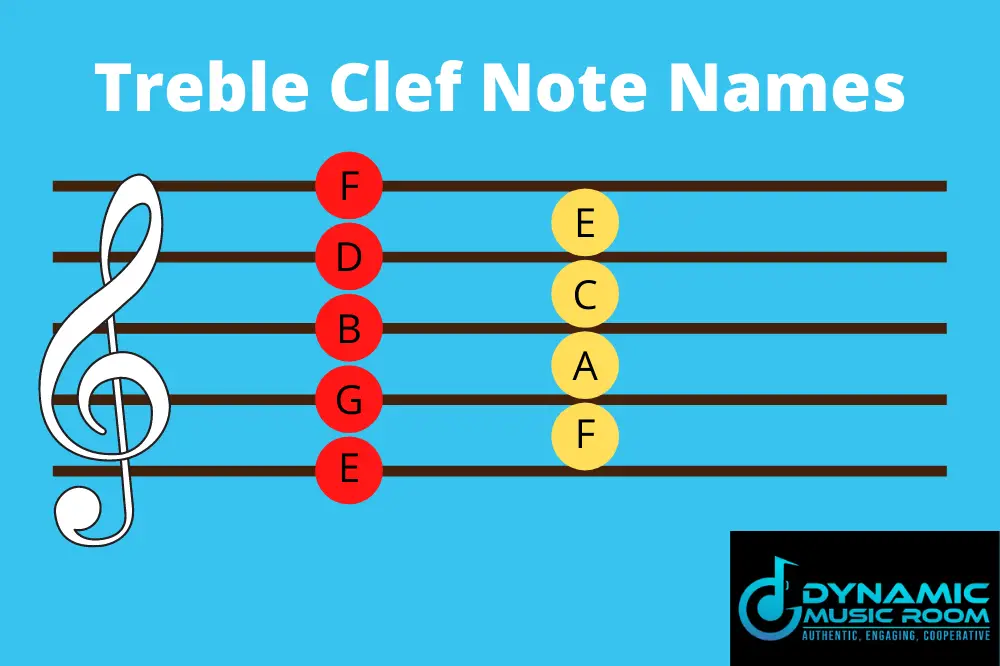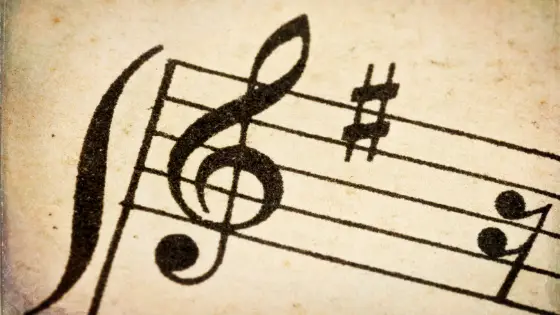Are you looking for ways to teach treble clef notes?
Do you feel like your teaching practices in this could use some new ideas?
Too many non-music teachers emphasize this concept as one of the only things we teach. It’s frustrating.
But it is something we should be teaching when it becomes appropriate.
I usually start this concept when students begin recording.
Regardless of when you start, there are some acceptable practices you may want to check out when it comes to teaching treble clef note names.
Teaching treble clef note names requires a combination of clear explanation and memorable tricks with engaging follow-up throughout. Our favorite ways to cover treble clef notes include:
- Lines And Spaces For Treble Clef Notes
- Mnemonics: Sayings To Help With Teaching Treble Clef
- Creative: Make Up Your Own Sayings
- Apply To Instruments Right Away: Make Treble Clef Note Names Practical
- Practice Over Time
- Get Physical When Teaching Treble Clef Notes: Manipulatives
- Use The Treble Clef Hand Staff
- Use A Floor Staff
- Treble Clef Note Learning Apps Are A Thing
Check out the rest of the post for details on each of these methods.
Table of Contents
How To Teach Treble Clef Note Names
There is no ONE way to teach treble clef note names. Anyone who tells you their way is the only and best practice is trying to sell you on their method.
In my years of teaching elementary students, I’ve discovered that mixing and matching methods and activities over time provides more in-depth knowledge that lasts over time.
This section covers a list of activities and tricks for helping students learn this necessary knowledge.
The first two, I always cover first. After that, I tend to rotate through the other activities in no particular order.
Whatever you decide to do, make sure you think about where the kids are and plan for less each day and more over time.
Lines And Spaces For Treble Clef Notes
First, we need to introduce the idea of the treble clef and what it is.
At this point, my students are familiar with the five-line staff. We’ve used it for solfege starting in first grade.
If your students aren’t familiar with the five-line staff, you may wish to back up and tell them how the staff evolved to show higher and low pitches.
Introducing Treble Clef
I put the five-line staff on the board and ask for a student to tell me which note is G.
Often, they stare at me (I haven’t taught them this, yet). Usually, there’s one kid who takes piano lessons and can answer.
I describe how we can use the staff to sing our solfege, but if we want to land on specific notes, we need to pin down which notes are which.
One of the first notes people needed to nail down is G. So, a long time ago, they drew this fancy G on the staff to show where G would be.
Then, I place it on the staff drawing attention to how the circle lands on the second line from the bottom.
This helped people remember where G was.
The Music Alphabet
Music is kind of funny; I tell the kids.
We only have 7 different notes, so our alphabet is different.
We start on A like everyone else does and move one letter for each note.
A-B-C-D-E-F-G.
But what happens if we want to go higher? They usually understand or guess because they know how after the solfege Ti, we sing Do again.
We repeat the letters.
I start with G on the staff. The class works their way up and down, filling out the staff with its letters.
Note: I make sure to write the line notes aligned and in one color, and the space notes aligned in a different color, as the image below shows.

Introducing Lines
At this point, I usually stop and move on. But the next step on a different day or if you wouldn’t press on is to draw attention to the line notes separately.
I circle the line notes and have students say them.
I point out how we describe where notes are:
- Lines vs. spaces
- Describe lines from the bottom
- Notes on the line have the line go through them
Introducing Spaces
I repeat the same steps with the space notes. I make sure to have students practice describing where the placement of the notes.
In my experience, I find it essential to reinforce what we mean when we say lines and spaces.
When teachers say “on the line” in writing, they mean letters that sit above the line.
When we say “on the line,” we mean when the lines go through the notes.
Drawing the contrast and pointing out the difference is key to avoiding confusion.
Mnemonics: Sayings To Help With Teaching Treble Clef
The biggest and most famous trick over time is to use sayings to remember the notes.
Almost everyone has heard some version of this.
Yes, everybody knows about this, but it’s stuck around because, for kids and adults, silly sayings are incredibly effective ways to help you remember things.
The space letters are the easiest. Starting from bottom to top, it spells F-A-C-E. It even rhymes with space! Easy, peasy.
If you wanted a saying, here are some I use for FACE:
- Funny Alpacas Can Eat
- Frozen Avocados Crunch Early
- Five Angry Cats Exclaimed
The lines, which spell E-G-B-D-F, are harder to remember, but they also have more sayings. Here are some classics and my favorites:
- Every Good Boy Does Fine
- Even George Bush Dances Funny
- Elephants Go Backward Down Freeways
- Even Greasy Boys Deserve Fudge
- Eleven Girls Bring Donuts Friday
Creative: Make Up Your Own Sayings
Now we’re getting into activities to rotate through to keep the knowledge fresh. One way I do this is by accessing their creative minds and letting them have ownership of their sayings.
They create their own.
I’ll do this in small groups (2-3) usually.
As they make up their own sayings (which they later write on the treble clef staff and share with the class), I circulate.
The most common problem I find is trying to make up sayings from the top down.
This isn’t exactly wrong, but we should avoid that since we describe notes from the bottom up.
Learn more about cooperative learning music activities.
Apply To Instruments Right Away: Make Treble Clef Note Names Practical
Another trick to consider is applying the treble clef note knowledge to instruments right away. Whether you’re playing recorders, xylophones, handbells, or boom whackers, getting it to use practically is fantastic.
Using notes they know how to apply, I’ll have them play the treble clef notes on their instruments while I point to it on the staff.
This helps reinforce how the notes are real music.
I even sneak in simple songs by changing the notes I’m playing in a specific order.
These 8 easy songs on the recorder are perfect for this.
Many of the following games combine well with applying to instruments right away.
Practice Over Time
This one is less an actual activity and more general teaching practice.
Reading treble clef notes fluently is a skill.
As we musicians know, you don’t develop skills by cramming in the knowledge in a short period.
It’s better to spread it out little by little over a long period.
Treble clef notes apply to this idea as well.
It’s better to practice 10-15 minutes every class over weeks and months than to spend a whole hour for two weeks.
Time and practice allow the knowledge to sink in better.
We know this, so I get frustrated when I see teachers make one or two lessons all about treble clef and then expect their kids to “know them.”
It’s like learning a whole other language. It takes time.
Get Physical When Teaching Treble Clef Notes: Manipulatives
I’m not saying to start punching the treble clef (although I expect some boys to be engaged while doing that!).
Physical manipulation is one of the learning styles we need to reach. Not just the visual and aural.
For the treble clef notes, we can create manipulatives to help students physically move and show where the notes are.
I print off what I call “Staff Mats.” These are just laminated pieces of paper with the treble clef staff on one side, and a plain old five-line staff on the other.
Students get some bingo chips and use them to place the notes on the staff.
They can match you as you do it on the board or place them on the note you tell them.
Either way, it’s more independent and more physical.
And it’s CHEAP!
Use The Treble Clef Hand Staff
Another way to physically show the treble clef notes is with the hand staff.
The hand staff is when you hold your hand up and tap the fingers and in between your fingers like they’re the staff’s lines and spaces.
A lot of people use this for solfege in earlier grades too.
I used to have students draw a treble clef or mark a circle on the knuckle where G would help them connect with the treble clef staff.
Some parents didn’t appreciate that.
Now I use little stickers (some have a treble clef when I get them), but a plain sticker will do too).
Use A Floor Staff
A floor staff is great fun for kids.
Either buy one in carpet or large nylon form.
Now the kids can do any activity they’d do with the manipulatives or hand staff with the floor.
This gets the whole body involved, although it does tend to slow down student engagement to a few at a time.
Using flashcards and challenging students to step on the correct note faster is a lot of fun, and it engages those reluctant, sports-heavy boys.
It even makes a great music center once they learn the game enough to play it independently.
Check out my favorite music centers and how to make music centers work in your classroom.
Flashcards
Yep. Flashcards are flashcards.
They may not be exciting or revolutionary, but they work.
Used alone, they’re just fine, but combine them with other games for lots of fun.
Show the flashcard and make it a race to see who can place the note with their manipulatives fastest.
Have them compete to step on the floor staff.
Put a staff on the board, give them fly swatters, and make them race to slap the notes—first one to 10 wins.
The possibilities are endless, and every little twist you can offer gives them more engagement and practice in learning treble clef note names.
Bonus Tip: Ask the students to create their own game using the flashcards.
I love seeing what they create.
Treble Clef Note Learning Apps Are A Thing
While teaching treble clef notes with actual in-person instruction is best, there are some great apps out there.
Kids (and adults) will enjoy some of these.
Check them out and share them with your students if you wish.
Final Thoughts
I hope this guide to teaching treble clef note names helps you keep your kids engaged.
There are a lot of ways to reinforce these concepts, and all of them work well.
I recommend doing as many different activities as you can with smaller chunks of activities over the weeks and months.
Make it as practical as possible and switch it up where possible.
Even small twists in well-known games will make it feel fresh to the kids and heighten their engagement.
I’ve taught adults using these techniques as well, and they find it a blast too.
Please don’t give up on this concept, but don’t let it become disconnected and boring.
If you don’t look forward to teaching it, the kids won’t enjoy learning it.

